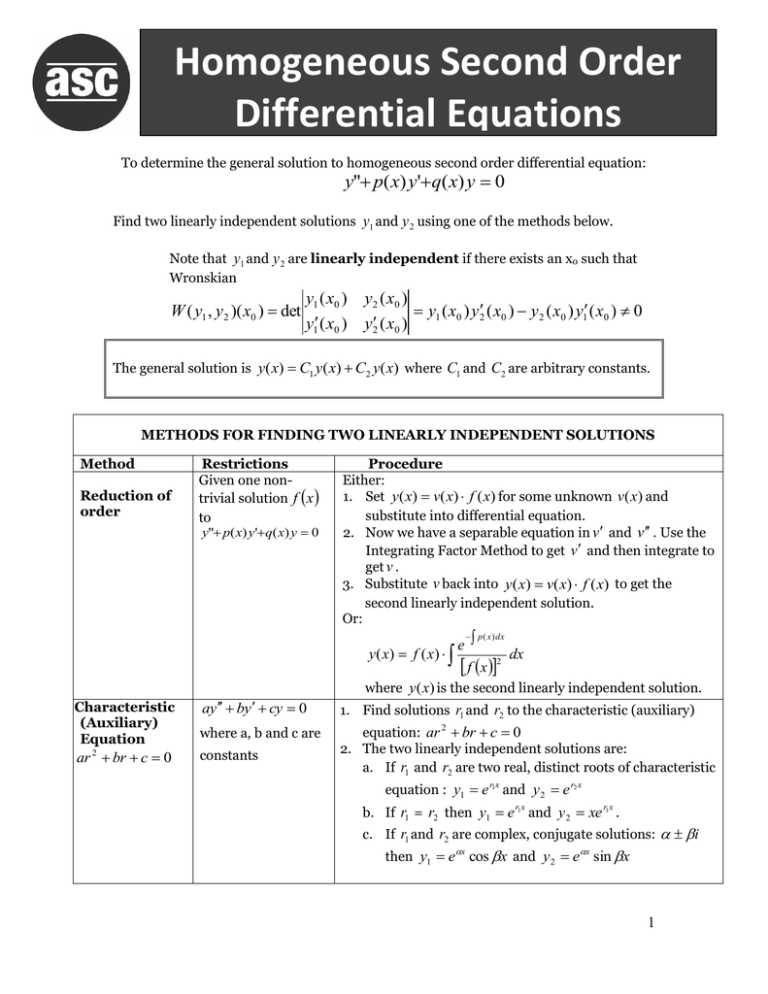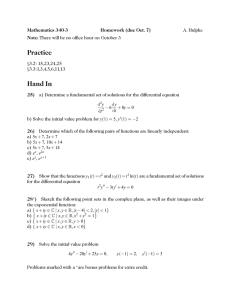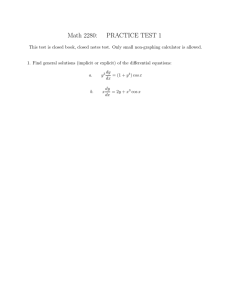Solving Homogeneous Second Order Differential Equations
advertisement

Homogeneous Second Order Differential Equations To determine the general solution to homogeneous second order differential equation: y" p( x) y'q( x) y 0 Find two linearly independent solutions y1 and y 2 using one of the methods below. Note that y1 and y 2 are linearly independent if there exists an x0 such that Wronskian W ( y1 , y 2 )( x0 ) det y1 ( x0 ) y1 ( x0 ) y 2 ( x0 ) y1 ( x0 ) y 2 ( x0 ) y 2 ( x0 ) y1 ( x0 ) 0 y 2 ( x0 ) The general solution is y( x) C1 y( x) C2 y( x) where C1 and C2 are arbitrary constants. METHODS FOR FINDING TWO LINEARLY INDEPENDENT SOLUTIONS Method Reduction of order Restrictions Given one nontrivial solution f x to y" p( x) y'q( x) y 0 ay by cy 0 Characteristic (Auxiliary) Equation where a, b and c are ar br c 0 constants 2 Procedure Either: 1. Set y( x) v( x) f ( x) for some unknown v(x) and substitute into differential equation. 2. Now we have a separable equation in v and v . Use the Integrating Factor Method to get v and then integrate to get v . 3. Substitute v back into y( x) v( x) f ( x) to get the second linearly independent solution. Or: p ( x ) dx e y ( x) f ( x) dx f x 2 where y (x) is the second linearly independent solution. 1. Find solutions r1 and r2 to the characteristic (auxiliary) equation: ar 2 br c 0 2. The two linearly independent solutions are: a. If r1 and r2 are two real, distinct roots of characteristic equation : y1 e r1x and y 2 e r2 x b. If r1 = r2 then y1 e r1x and y 2 xe r1x . c. If r1 and r2 are complex, conjugate solutions: i then y1 ex cos x and y 2 ex sin x 1 METHODS FOR FINDING TWO LINEARLY INDEPENDENT SOLUTIONS (cont.) Method Variable Coefficients, (CauchyEuler) Restrictions Procedure ax y bxy cy 0 1. Substitute y x m into the differential equation. It 2 x0 simplifies to am 2 (b a)m c 0 . If m is a solution to the characteristic equation then y x m is a solution to the differential equation and a. If m1 and m 2 are two real, distinct roots of characteristic equation then y1 x m1 and y 2 x m2 b. If m1 m2 then y1 x m and y 2 x m ln x . c. If m1 and m 2 are complex, conjugate solutions i then y1 x cos ln x and y 2 x sin ln x Example #1. Solve the differential equation: 2t y ty 3 y 0 , given that y1 (t ) t 1 is a solution. 2 Solution: 1 Let y(t ) v(t ) y1 (t ) v t y (t ) v(t ) y1 (t ) v(t ) y1 (t ) v t 1 v t 2 y (t ) v(t ) y1 (t ) 2v(t ) y1 (t ) v(t ) y (t )1 v t 1 2v t 2 2vt 3 2t 2 y ty 3 y 0 2t 2 v t 1 2v t 2 2vt 3 t v t 1 v t 2 3 v t 1 0 2tv 4v 4vt 1 v vt 1 3vt 1 0 2tv 3v 0 Let v u so v u then 2tv 3v 0 2tu 3u 0 3 u u 0 (First order linear equation) 2t ut 3 2 v 5 2 52 t , at this point we can ignore the constant coefficients so take v t 2 5 Substitute v back into y(t ) v(t ) y1 (t ) to get the second linearly independent solution. y 2 v y1 t 5 2 t 1 t 3 2 The general solution is: y C1 y1 C2 y2 y C1t 1 C2t 3 2 2 Example #2. Solve the differential equation: y 2 y y 0 Solution: Characteristic equation: r 2 2r 1 0 r 12 0 r 1, r 1 (Repeated roots) y1 C1e x and y 2 C2 xe x So the general solution is: y C1e x C2 xe x Example #3. Solve the differential equation: t 2 y (t ) 4ty (t ) 4 y(t ) 0 , given that y(1) 2 , y (1) 11 Solution: The substitution: y t m yields to the characteristic equation: m 2 (4 1)m 4 0 m 2 5m 4 0 (m 4)(m 1) 0 m 4 or m 1 two distinct, real solutions So the solutions are: t 4 and t . The general solution is y C1t 4 C2t Use y(1) 2 , y (1) 11 to find the solution to the initial value problem: y(1) 2 C1 C2 2 y (1) 11 4C1 C2 11 Solving the system of linear equations gives us C1 3 and C 2 1 So the solution to the Initial Value Problem is y t 3t 4 You try it: 2x 1. Given that y1 ( x) e 3 is a solution of the following differential equation 9 y 12 y 4 y 0 . Use the reduction of order to find a second solution. (Hint: v 0 implies v 1 ) Find the general solution of the given second-order differential equations: 2. 3 y 2 y y 0 3. x 2 y 5xy 4 y 0 3 Solutions: #1: y 2 xe 2x 3 2 2 x C 2 sin x C1 cos 3 3 #3: y C1 x 2 C2 x 2 ln x #2: y e x 3 4


